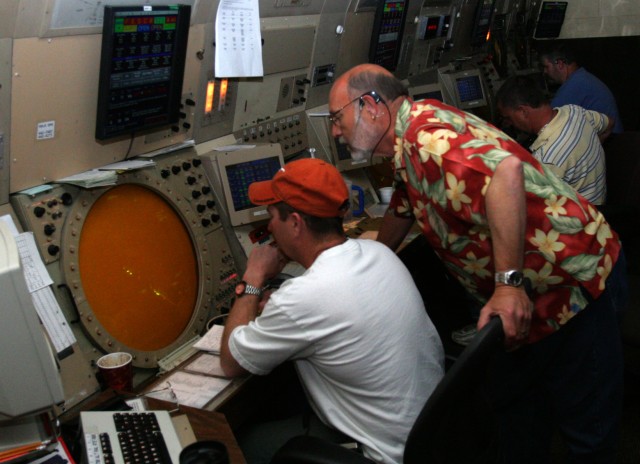
FORT SILL, Okla.-- For the average person, Fort Sill's often tranquil atmosphere now and then punctuated by artillery fire, hardly seems the setting for a beehive of activity, and yet, high above that is exactly what happens here.
To ensure the continued management of this airspace, the Army deputy chief of staff for operations signed documents recently keeping the Army Radar Approach Control operational here at the hands of civil service air traffic controllers.
Buddy Thornton, air traffic control chief and airspace officer, heads a staff of maintenance professionals and controllers who man the ATC tower during the week and provide 24/7 coverage of Fort Sill and surrounding airspace via the ARAC. On an average month controllers may handle 300-400 controller assisted, precision approaches. However, this number is but a fraction of the 15,000-16,000 operations his staff handles for in-flight aircraft either entering or departing Fort Sill's airspace.
"With artillery firing on both sides of the runway, nearby small arms fire, helicopter operations, close air support of army training and jet pilot training all going on at the same time, it's essential to have this all controlled by experienced DoD personnel," said Thornton. "You cannot have a fires mission without having aircraft involvement in it, and to do that you need controlled airspace to ensure mission success."
Working for the Department of the Army and Fort Sill Garrison, Thornton's staff follows their directives to meet the post's mission requirements. They also support the vision of Maj. Gen. David Halverson, Fires Center of Excellence and Fort Sill commanding general, for the integration of air support with Fort Sill's training requirements.
"If there's going to be a big exercise, we coordinate the airspace needed and manage a traffic pattern that may involve F-16s, F-18s, unmanned aerial systems and helicopters," said Thornton.
His controllers also support field operations for both the U.S. Air Force and Canadian air force's joint tactical air controller courses, and Air Force Joint Fires Observer training here.
Because all aircraft arriving at post land from the north, they must fly through restricted airspace. Thornton maintains an agreement with range control of when and where restricted airspace can be closed for artillery firing. One access route can only be closed with a 10-day notice to provide controllers the time to alert surrounding installations of the situation.
In a sense, ARAC personnel also have their hands on artillery lanyards. Although they coordinate to ensure aircraft not authorized to be in restricted airspace stay out, they also have the responsibility to stop fire if an aircraft does not respond and appears likely to enter a restricted area. Once the aircraft clears the area, ARAC personnel give the authorization to resume firing.
Thornton likened this swarm of aircraft activity aloft to herding cats, except in this case its 300-mph cats and keeping them either inside or outside restricted airspace and away from each other.
"We're here to make sure aircraft do what they're supposed to do," he said.
The signing ends years of discussions that first began in the late 1980s between the DoD and the Federal Aviation Administration as to who would staff the facility. Around 2004 the Fort Sill Commanding General sent a letter to the Army suggesting the Army retain control of the ARAC to best meet the Army's mission requirements here.
"This is an extremely busy location for air traffic controllers, and even experienced controllers need six to 12 months training to become certified on all required tasks," said Thornton.
Maximizing that manpower, all certified controllers can work either ARAC or tower positions; they also provide support to flight training out of surrounding Air Force bases. Sheppard Air Force Base sends its Euro-NATO joint jet training here for instrument training mainly through Fort Sill but also via the Duncan or Lawton airports. T-6 trainer aircraft pilots also practice their emergency landing procedures here.
To the north, Vance Air Force Base has a contingent of Marine and Navy pilots who require radar approach training, a capability the base cannot provide. Instead they fly to Fort Sill to meet this requirement for graduation.
Thornton said Fort Sill controllers also work aircraft inside and outside of restricted air space maintaining communications and providing better control and awareness of what each aircraft is doing.
When C-17 aircraft began airdrop operations here, that ended about six weeks of coordination by Thornton's staff to get the procedures down to handle this new mission. He added, assault landing strip markings are painted on the runway to allow C-17 crews to practice combat arrivals and departures. The current runway is 5,000 feet long and 200 feet wide, however, the new markings restrict C-17s in training to a much smaller 3,500-foot long by 90-foot wide portion.
Along with the load of ATC operations on post, Thornton's staff also provides radar coverage of Halliburton Field in Duncan and the Lawton-Fort Sill Regional Airport, each of which only maintains a staff of tower personnel.
Army National Guard unmanned aerial systems added to this high-demand facility flying training missions in support of upcoming deployments earlier this fall. No decision has been made for the permanent location of these ANG assets.
Thornton added Fort Sill brigades should all get UASs between now and 2015.

Social Sharing